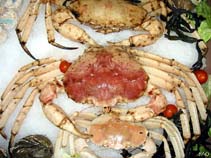Chaceon fenneri (Manning & Holthuis, 1984)
Golden deepsea crab| Native range | All suitable habitat | Point map | Year 2050 |

|
| This map was computer-generated and has not yet been reviewed. |
| Chaceon fenneri AquaMaps Data sources: GBIF OBIS |
Classification / Names Common names | Synonyms | CoL | ITIS | WoRMS
Malacostraca | Decapoda | Geryonidae
Environment: milieu / climate zone / depth range / distribution range Ecology
Benthic; depth range 200 - 2002 m (Ref. 101759). Deep-water; 7°C - 16°C; 38°N - 23°N, 88°W - 64°W
Distribution Countries | FAO areas | Ecosystems | Occurrences | Introductions
Western Atlantic: South Atlantic Bight, the Gulf of Mexico and Bermuda.
Length at first maturity / Size / Weight / Age
Maturity: Lm ?, range 9 - 16.9 cm Max length : 19.0 cm CW male/unsexed; (Ref. 101836); max. published weight: 2.0 kg (Ref. 101836)
Short description Morphology
Carapace broader than long. Median pair of frontal teeth separated by a wide sinus, teeth scarcely overreaching obtuse lateral frontal teeth. Orbits usually more than 3/4 frontal width. Anterolateral teeth 5, second and fourth reduced, distance between first and third usually smaller than distance between third and fifth. Cheliped with blunt lobe on upper margin of merus, carpus lacking outer spine, propodus lacking distal dorsal spine. Meri of pereiopods lacking distal dorsal spine. Fifth leg: merus broad, less than 2/3 carapace width; propodus broad, length less than 4.5 times width; propodus and dactylus subequal in length, or dactylus slightly longer. Dactili of pereiopods compressed, narrow, height at midlength much greater than width. Color: tan to cream.
Maximum depth from Ref. 97531 Inhabits the continental slope on flat foraminiferan ooze habitat, coral mounds, ripple habitat, dunes, black pebble habitat, rock outcrops, and soft-bioturbated habitat (Ref. 367). Also in muddy and muddy-sandy bottoms (Ref. 101384). Opportunistic feeder (Ref. 104380).
Life cycle and mating behavior Maturity | Reproduction | Spawning | Eggs | Fecundity | Larvae
Life cycle: Eggs are incubated for approximately six months after which the larvae hatch. Mating behavior: Mating occurs immediately after the female's molting. Precopulatory behavior is characterized as the formation of a protective cage around the female by the male using its legs.
Main reference
References | Coordinator | Collaborators
Tavares, M. 2003. (Ref. 367)
IUCN Red List Status (Ref. 130435)
CITES status (Ref. 108899)
Not Evaluated
CMS (Ref. 116361)
Not Evaluated
Threat to humans
Human uses
Fisheries: commercial
| FishSource |
Tools
More information
Internet sources
BHL | BOLD Systems | CISTI | DiscoverLife | FAO(Publication : search) | Fishipedia | GenBank (genome, nucleotide) | GloBI | Gomexsi | Google Books | Google Scholar | Google | PubMed | Tree of Life | Wikipedia (Go, Search) | Zoological Record
Estimates based on models
Preferred temperature
(Ref. 115969): 6.5 - 14.5, mean 11.1 (based on 45 cells).
Price category
(Ref. 80766):
Unknown.



